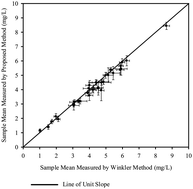Modification of Winkler's method for determination of dissolved oxygen concentration in small sample volumes
Abstract
Winkler's method is the most popular procedure for determination of dissolved

* Corresponding authors
a
Environmental Engineering and Management Programme, Department of Civil Engineering, Indian Institute of Technology Kanpur, Kanpur, India
E-mail:
pbose@iitk.ac.in, vinod@iitk.ac.in
Fax: +91 512 259 7395
Tel: +91 512 259 7792
Winkler's method is the most popular procedure for determination of dissolved

 Please wait while we load your content...
Something went wrong. Try again?
Please wait while we load your content...
Something went wrong. Try again?
A. Shriwastav, G. Sudarsan, P. Bose and V. Tare, Anal. Methods, 2010, 2, 1618 DOI: 10.1039/C0AY00110D
To request permission to reproduce material from this article, please go to the Copyright Clearance Center request page.
If you are an author contributing to an RSC publication, you do not need to request permission provided correct acknowledgement is given.
If you are the author of this article, you do not need to request permission to reproduce figures and diagrams provided correct acknowledgement is given. If you want to reproduce the whole article in a third-party publication (excluding your thesis/dissertation for which permission is not required) please go to the Copyright Clearance Center request page.
Read more about how to correctly acknowledge RSC content.
 Fetching data from CrossRef.
Fetching data from CrossRef.
This may take some time to load.
Loading related content
